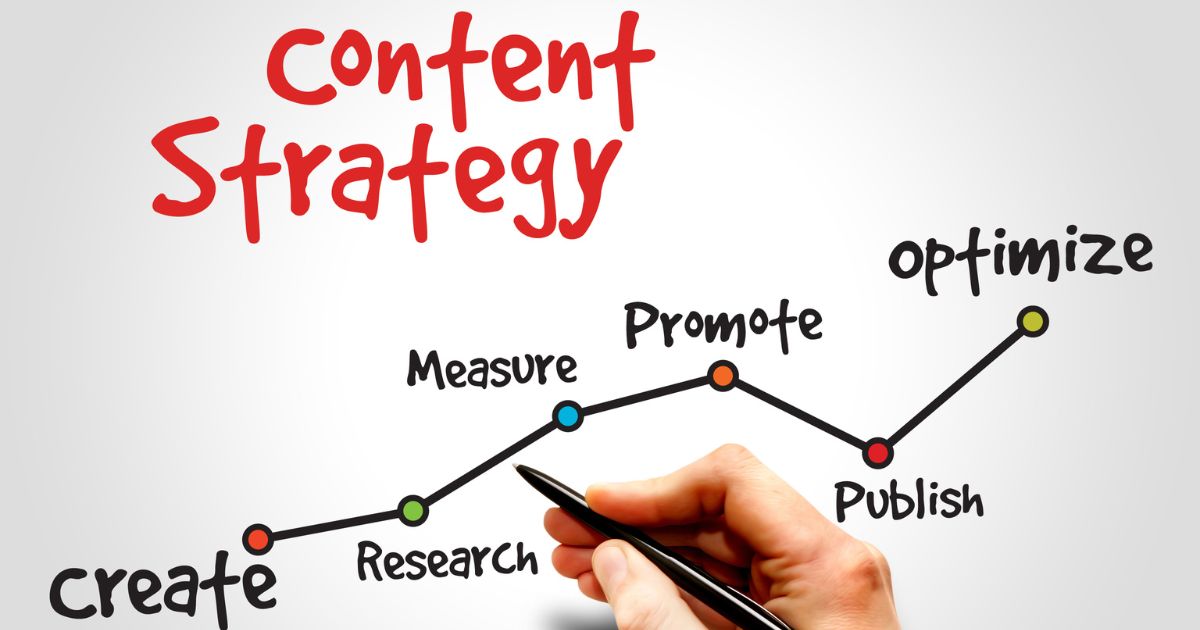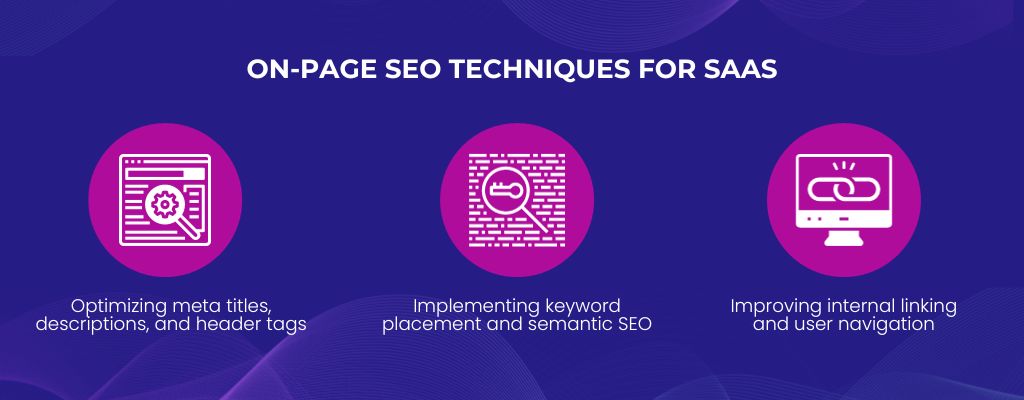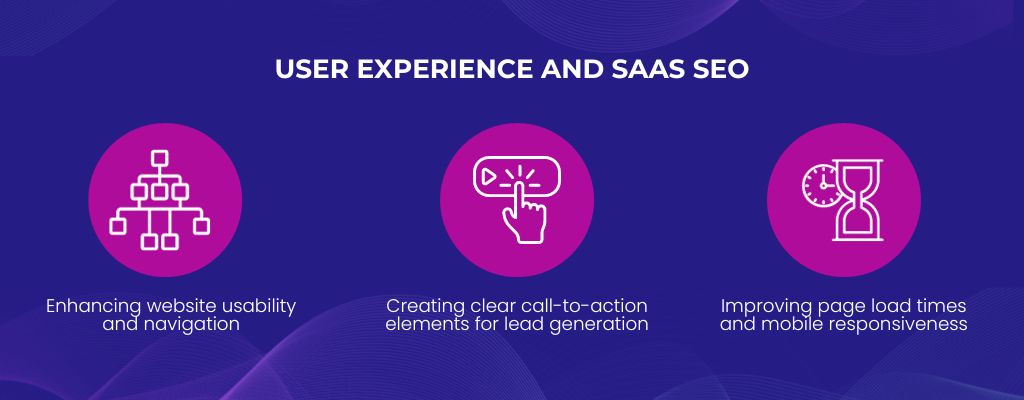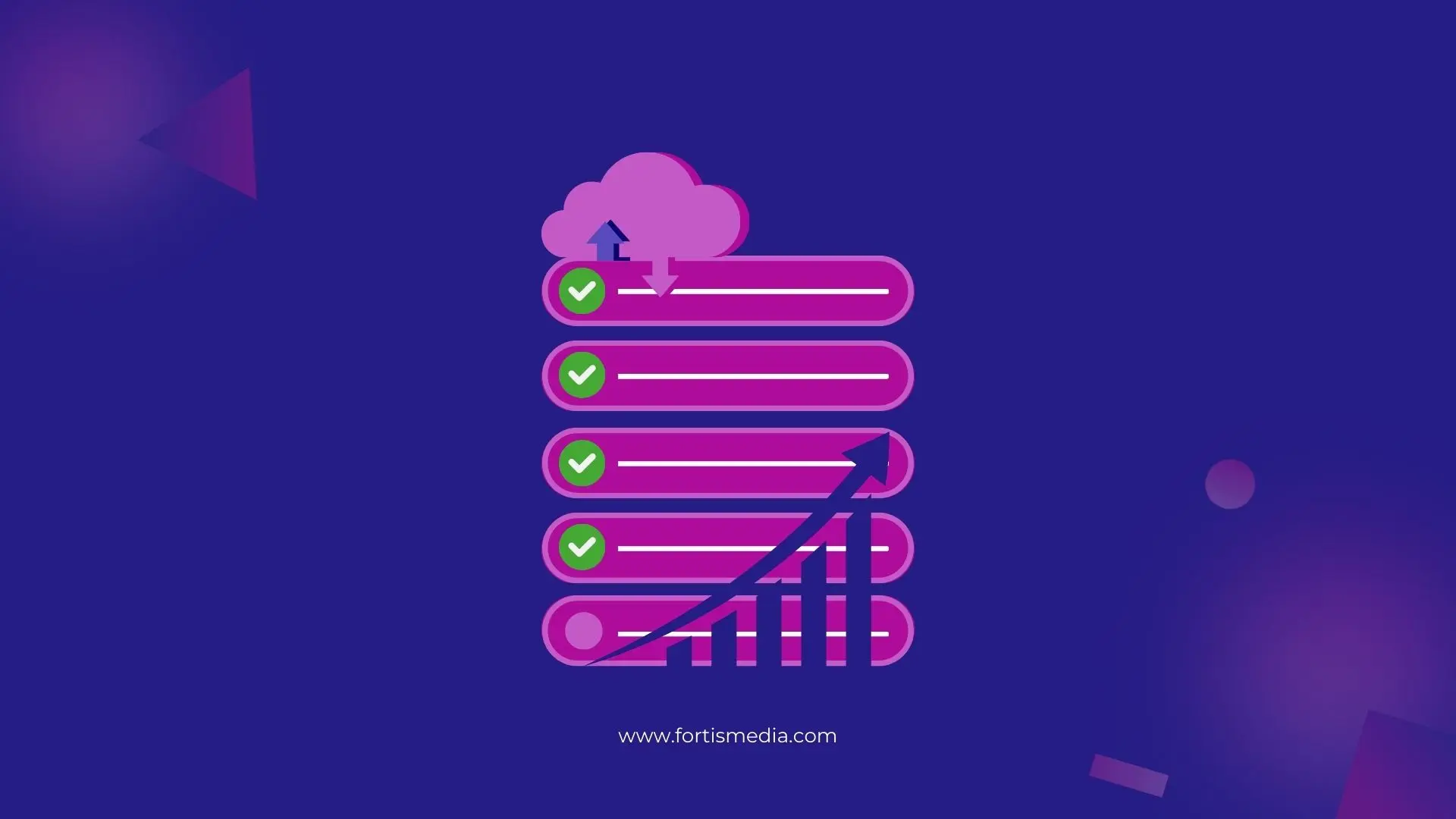SaaS SEO Strategy: The Complete Guide for 2023

Book Your SEO Audit Today
Book a demo1. Setting S.M.A.R.T Goals for SaaS SEO
Increasing your SaaS website’s visibility is step-by-step unless you go controversial or positively viral. To this point, you must set S.M.A.R.T. goals for specific, measurable, achievable, relevant, and time-bound objectives. Learn more about these SaaS SEO goals in the following sections.
Defining Specific, Measurable, Achievable, Relevant, and Time-bound goals
The S.M.A.R.T way of plotting SaaS SEO goals is by maintaining a realistic approach. Rather than targeting a 20% increase in conversion rate in the first couple of months of launching your campaign, you may tone down a bit by targeting a 20% increase in website traffic instead.
It’s not about shying away from aspirations but more about taking a route without any shortcuts. That’s what the S.M.A.R.T is all about — setting up specific, relevant goals that you can achieve in each period. Attaining these measurable goals will set you up for the next step of your SaaS SEO campaign.
Establishing clear objectives for increased website traffic, lead generation, and conversions
Establishing clear-cut, attainable goals will help you stay on the right course when doing SEO strategy for SaaS products or services. For example, you should focus on the foundational goals if you’re just starting your SaaS SEO journey. Along with keyword research and lead generation, you should optimize your website performance by reducing your page loading speed to under 2 seconds.
As you complete these starting goals, you can focus on increasing your conversion rate and revenue next. The key is to have a ladder-like goal system where you must take little steps to get to the next level.

2. Comprehensive Keyword Research for SaaS
Keyword research is at the heart of any SEO strategy, especially on SaaS products and services. This is one of the best ways to understand your audience further, which should be central to your content planning and marketing campaigns.
Understanding the SaaS audience and user intent
Buyer intent has always been integral to SaaS marketing, which has trickled down to the SEO space. What is the purpose of a potential customer when they click on your website? How likely are they to purchase this product over that other product? Do they tend to click on products that have this specific feature?
You can capture user intent through free tools like Google Analytics or tap into third-party apps like HubSpot and Ahrefs. Moreover, you can also send out surveys and newsletters or initiate conversations and first-hand feedback with existing customers.
Identifying relevant short-tail and long-tail keywords
You must capture your niche and sub-niches when doing a SaaS SEO strategy. Just like in product development, where you want to be as unique as possible, you also want to be extremely specific in targeting keywords for your content.
In terms of coverage, there are two types of keywords in SEO. Short-tail keywords are broader in space and act as the umbrella topic. On the other hand, long-tail keywords are more specific, as they target demographics like location and category.
It’s great to balance these two keyword types, but long-tail keywords could speak more to your niche audience, which would help you rank higher in SERPs (Search Engine Results Pages).
Utilizing keyword research tools and competitive analysis
Here’s some good news: You don’t have to do keyword research alone. Whether a small SaaS website or an enterprise-level one, you can tap into free keyword research tools like Google Search Console and Google Analytics, along with the free limited versions of Ahrefs, Moz, Semrush, and Ubersuggest.
When using these keyword research tools, you should also look at the high-ranking keywords that your competitors are using. This will give you a data-driven insight into the keywords that work, although you must remember that they only rank high for a specific period. You should continue optimizing your keyword research as consumer interests and market trends change.

3. Content Strategy for SaaS SEO
There are many categories for creating content for SaaS SEO. Along with your product descriptions, you must fill up your website with high-ranking, informative posts like whitepaper, case studies, testimonials, and how-to blog posts. Drawing up your content strategy is usually a year-long series of posts, so you must point your plan in the right direction.
Creating valuable and authoritative content for the target audience
Even if you have identified who your target audience is, the work of determining their interests continues. As mentioned, consumer interests change over time, sometimes in concise bursts.
So, if you want to create valuable and authoritative content for your target audience, there has to be a continuous effort to study their behavior and needs. Whether through regularly scheduled keyword research, focus groups, or direct conversations with existing customers, getting more information about the target audience is critical in a SaaS SEO content strategy.
Mapping keywords to content themes and topics
Doing keyword research will produce a cloud of words or phrases you need to organize. You want to assign specific keywords for each website page, so you’ll know that each base is covered. The strategy for doing this is keyword mapping, a tool to organize your relevant keywords.
Mapping keywords is the process of organizing important information about each keyword, including these categories:
- Webpage
- Page URL (Uniform Resource Locator)
- Total Searches
- Primary Keyword
- Secondary Keyword
- Tertiary Keyword
- Monthly Search Volume
It’s easier to connect specific keywords to each page of your SaaS website through keyword mapping.
Incorporating blog posts, eBooks, case studies, and infographics
A SaaS SEO website is not all about flaunting the features of your products and services. You also have to provide an air of authority and legitimacy, which you can achieve through blog posts, eBooks, case studies, and infographics.
For example, a case study about a client you helped will lead your website visitors to think you know your stuff. Moreover, writing informative content like step-by-step guides, listicles, and how-to blogs could also help you win conversions. These potential customers just want to know if you can give them the solution they need, and crafting content around those solutions will help you rank higher and improve engagement.

4. On-Page SEO Techniques for SaaS
SEO strategy for SaaS is not all about keyword research and content planning. When you’re done writing the body of your new post, there are on-page elements that you need to optimize to ensure that your page is maximizing its chances of ranking on the first page of search engine results pages.

Optimizing meta titles, descriptions, and header tags
Your meta titles, descriptions, and header tags are the sets of information that people see when they stumble upon your page on SERPs. Search engines like Google also prioritize crawling these meta tags to ensure you rank on the keywords you’re using.
To optimize your meta tags, here are a few tips to get you started:
- For meta titles, make sure you put your keyword/s first since users will only see the first 35 characters of your title on search engines.
- For meta descriptions, ensure you have your keywords and a brief CTA (Call-To-Action) in the first 160 characters.
- For the header tags, ensure you only have one H1 and consider using your primary keyword on your first H2.
Implementing keyword placement and semantic SEO
The term ‘ Semantic SEO ‘ comes to mind when discussing the connection between high-ranking pages and long-tail keywords. Instead of focusing on one-word keywords, search engines like Google use semantics to understand your content better.
You must include multiple related keywords on one page as an integral part of content planning and finishing. If you’re talking about a particular product, you don’t just write about its features and descriptions. You also include practical information like benefits, alternatives, pricing, and future trends. This way, you’re trying to answer every user question, which would put you in the good graces of semantic SEO.
Improving internal linking and user navigation
Much has been said about linking to one or two high-ranking external sources on a single page. However, people overlook that internal linking helps spread authority juice, decreasing your bounce rate.
When writing your content, including at least two relevant internal links, especially the high-ranking ones, would be beneficial. Note that you can’t just internally link to random pages on your website, as this will only confuse user navigation.
As you can see by now, content planning is not just limited to keyword research and the writing process. You must smoothen on-page elements, especially internal linking, and user navigation, during content planning.
5. Link Building Strategies for SaaS SEO
You must optimize off-page elements such as link building, keyword research, and on-page SEO. Collecting backlinks from other high-authority websites, particularly ones relevant to your SaaS website, will help you rank higher in search engine results pages. Read more below to find out how.
Building high-quality backlinks from relevant sources
While there’s the option to pay a significant amount of money to get backlinks, it might not be the best path for SaaS websites, especially those that can’t yet shell out tons of resources. Even if you’re willing to pay for backlinks, web admins from high-authority sites would still want to see some layer of authenticity from your SaaS website.
When you’re in the link-building phase of SaaS SEO strategy, you need to consider these things:
- Always target getting backlinks from websites that are relevant to your SaaS company
- Make sure that you already have a library of legitimate and informative content
- Optimize your website structure and page loading speed
Guest posting, influencer outreach, and partnerships
Doing link building isn’t about how much value you’re getting from the backlinks you collect; you also need to provide some value to the website you’re reaching out to. If you’re requesting a guest post slot — even if you’re paying for it — you need to craft content that will provide solutions for that website’s target audience.
Engaging in partnerships and influencer marketing is also viable for growing your online visibility. However, you should also research the reputation of the brand you’re collaborating with. Social responsibility and brand value are of greater importance in digital marketing, so you need to consider these elements in your SaaS SEO strategy.
Leveraging content for natural link acquisition
While it’s true that paid links and brand partnerships are legal avenues for link building, the best way to get high-quality backlinks is still via your content. If you have a library of relevant, informative, factual, and engaging content, it’s more likely that other websites will naturally link to you as a reference.
Despite different off-page SEO techniques, content is still king in this space. Pouring your energy and resources into writing audience-centered, trending content is always worth it.

6. Technical SEO Considerations for SaaS
Even if you have the best content out there, it will be fine if your website takes a very long time to load. Page loading speed and other technical SEO considerations like UX (User Experience) significantly contribute to your SaaS website’s online visibility.
Ensuring mobile responsiveness and user-friendly design
A more significant chunk of searches and queries on Google come from mobile devices. It’s not surprising, given that almost everyone has a handheld device nowadays. It only makes sense that your SaaS website is as mobile-friendly as possible.
Having a mobile-responsiveness structure will provide you with these advantages:
- Longer session duration
- Lower bounce rate
- Higher chances of ranking on the first page of SERPs
While you can always manually code a mobile-friendly design, most CMS (Content Management System) platforms automatically optimize this SEO component. In addition, you can also tap into responsive web design tools like Bootstrap, Wirefy, and FitVids.
Optimizing site speed and performance for a better user experience
Speaking of responsiveness, your website should load quickly on all devices. A page loading time of 3 seconds is acceptable, but if your website needs more than that to load, then it’s likely that you’ll need help. It might lead to users leaving your site immediately, causing you to miss out on potential acquisitions.
A poorly structured website design, plus too many advertisements and multimedia elements, are some of the reasons why a web page loads slowly. Fortunately for you, there are tools that you can use to optimize your site speed. Look at these tools:
- TinyPNG
- CSS Minify
- Google PageSpeed Insights
- Toptal HTML Minifier
- Cloudflare
Implementing structured data for rich search results
To help users discover more information about websites in just one search, Google implemented rich results in 2016. It enabled users to learn more about a specific website right on the search engine results page without clicking on any links.
Through rich results, SaaS websites can show off their products right away. Customer reviews, ratings, and company information are some of the most common rich effects. You can use Google’s Structured Data Markup Helper to implement structured data. However, you should also do your part to ensure that every information on your website is accurate and up to date.
7. Mobile-First SEO Strategy for SaaS Companies
According to Statista, over 60% of the global internet population uses mobile devices to do things online. When translated into pure numbers, that’s over 5 billion mobile users, a large consumer base you can target with mobile-first indexing.
Understanding the growing importance of mobile-first indexing
If you still don’t buy into the trend of mobile-first SEO strategy, here’s a quick fact: Google found out that mobile users tend to have a higher buying intent than people who use desktops. That fact affects a SaaS SEO strategy’s KPIs (Key Performance Indicators).
What is the reasoning behind the growing importance of mobile-first indexing in SaaS SEO? Here are a couple of customer-centered explanations:
- Since you’re a SaaS company, users expect you to keep up with technological trends. With mobile purchases becoming the norm, your visitors need your website to be mobile-responsive.
- People are inclined towards mobile purchases because of their convenience, especially on the go. If your website is not optimized for mobile use, you take that convenience away from them.
Optimizing websites for mobile responsiveness and user experience
Earlier, we discussed mobile responsiveness and the nuances you’ll face if you don’t optimize your site. Along with page loading speed, a mobile-first approach also includes improving your UX.
When discussing UX, you want to make each session as smooth as possible. It means having consistent and logical website navigation and a simplified UI (User Interface) to help your visitors quickly find what they need.
If you can keep your website simple and interactive, you’re going in the right direction.
Utilizing AMP (Accelerated Mobile Pages) for faster mobile loading times
If you’re serious about making your website mobile-responsive, you could activate your AMP option. Consider it a dietary program for your website; it’s a lightweight iteration that only retains the most essential parts of a particular web page.
AMP will remove several non-essential elements like ads and videos, so some websites deviate from it. But if these ads aren’t your bread and butter, it won’t hurt to turn on your AMP for a better user experience.
Implementing schema markup to enhance mobile search results
Google is leaning more towards giving users every information they need right on the first page of a search engine results page. This includes rich results, which you can optimize by implementing schema markup.
To generate your schema markup, you can use these free tools:
- Merkle Schema Markup Generator
- Google Structured Data Markup Helper
- ChatGPT
Most importantly, all business information presented on your website must be factual and up to date. You don’t want people to contact you on a discarded email address, as you’ll lose out on potential conversions.

8. User Experience and SaaS SEO
We’ve talked about UX a few times already in this article. If you’re still not sold on the importance of user experience in SaaS SEO strategy, don’t worry; we dedicated a whole section for it.

Enhancing website usability and navigation
The primary benefit of a great UX is to help users find what they need. Your visitors should be able to navigate your website easily, and you can only provide that if you invest in a good UX design.
To enhance your SaaS website navigation, these essential elements should be present:
- Visible CTA buttons that lead to relevant internal links
- Simple interface with a balanced distribution of text and multimedia
- Up-to-date and accurate information
The secret behind a good UX design is not the many visual elements. Instead, it’s about arranging these visual elements in a coherent and intuitive manner.
Creating clear call-to-action elements for lead generation
When doing SEO strategy for SaaS websites, it’s not enough that you’re seeing drastic improvements in visits and SERP click-through rates. To move the needle, you need to have an increased engagement rate, which could lead to unprecedented growth in conversions.
To see real growth in your SaaS website, you can start by optimizing your CTA elements. Your CTA could come in different forms, from text links to buttons and pictures. The important thing is that these CTA elements are visible, relevant, and clear-cut.
Improving page load times and mobile responsiveness
You can have dynamic CTAs and intuitive navigation, but these won’t matter if your page loads very slowly. Page load speed becomes even more crucial when you’re driving almost all of your traffic from mobile devices.
People think of accessibility and convenience when they use their smartphones for purchases and information-gathering. If your website’s loading speed hinders them from entering your page quickly, they will likely end the session immediately.
9. Data-Driven Decision-Making in SaaS SEO
The beauty of doing SEO is that it comes with digital tools that help you analyze and monitor what you’re looking for. It becomes easier for you to make decisions strategically and product-wise as you have all these data and insights backing you up.
Setting up SaaS-specific SEO analytics tools
As we’ve said, you don’t have to do your SaaS SEO strategy by yourself. There are SEO tools that will make your life easier, and most of them come with free versions. Google Analytics, the free tool that you can quickly integrate to your website, is the most accessible SEO analytics tool for you.
It’s not just Google Analytics, though. There’s a myriad of valuable tools that you can use to analyze your SaaS SEO strategy, including the ones below:
- Moz
- Ahrefs
- Semrush
- Yoast
- SE Ranking
- Woopra
- Ubersuggest
Monitoring organic traffic, keyword rankings, and conversion rates
Tracking your SaaS SEO campaign’s performance is just as important as planning the whole strategy. Consumer interests and market trends can change quickly, so you have to keep up with the evolving nature of SEO.
Google Analytics is still the best tool for monitoring organic traffic, while Ahrefs, Rank Tracker, and Google Search Console could be your best options for tracking keyword rankings. The takeaway is that you have specific tools for particular KPIs, giving you enough resources to track the metrics you need to address.
Using data insights to refine and optimize the strategy
These SaaS SEO analytics tools and monitoring efforts won’t matter if you’re not willing to refine and optimize your strategy. Launching an SEO strategy is always a trial-and-error process; it’s even recommended that you create two different campaigns simultaneously to see which tactics work the best for your target audience.
If you have the analytics data, the next step is to use these insights to drive a better, fully optimized SaaS SEO strategy.

10. Adapting to Future Trends in SaaS SEO
Driven by the technological advancements we have every year, there’s no doubt that the SaaS SEO space will see more changes soon. Here are several near future trends in SaaS SEO.
Preparing for voice search and AI-driven search results
From wired telephones to the wireless smartphones that we have today, most people love to converse by talking rather than manually typing in the words they want to say. It’s only a matter of time before this hands-free communication fully translates to search engine results pages.
While this hasn’t been a global hit yet, you should know that 50% of people in the United States use voice search daily. As soon as the technology catches up on the other parts of the world, you’ll see more websites fine-tuned to voice and AI-driven search results.
Embracing video and visual content for enhanced engagement
Visual content as a needle mover has been here for some time now. People are probably thinking, “Why do I have to read long-form content if I could just consume the necessary information via video?”
In Google, videos are already taking over the search results. Using keywords on video descriptions, visual content is now ranking on Google. This is the trend now, and it doesn’t hurt to go with the flow.
Staying agile in response to evolving search engine algorithms
In 2022, Google released a significant algorithm change focused on helpful content over keyword-rich pages. Many web admins pored over this big news, but this wasn’t the only time Google released an algorithm change. You should know that Google makes minor to medium algorithm changes every month, which you should watch.
Conclusion
The SaaS SEO space is ever-changing, encompassing consumer interests, market trends, and technological advancements. A single change in one of these areas could have a ripple effect on the whole industry.
It’s only natural that you’ll make many changes and optimizations to your SaaS SEO strategy as you go along. A brilliant SEO strategy a few months ago may not be less effective today. This is why you should always do the legwork even when you manage to rank on the first search engine results pages.
We will also continue to update this page to the tune of algorithm changes and evolution. If you want to stay up to date with SaaS SEO strategy advancements, make sure that you always check in on this article or contact us for more information.











